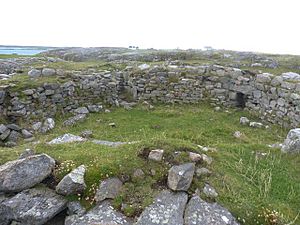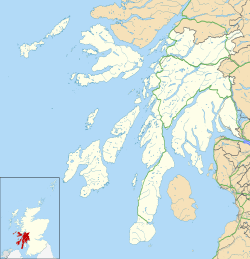Dun Mor Vaul facts for kids

Interior of Dun Mor
|
|
| Alternative name | Dùn Mòr |
|---|---|
| Location | Tiree |
| Coordinates | 56°32′31″N 6°48′49″W / 56.542061°N 6.813492°W |
| Type | Broch |
| History | |
| Periods | Iron Age |
Dun Mor Vaul (also called Dun Mor) is an ancient stone tower. It's known as a Broch. You can find it on the north coast of Tiree, an island in Scotland. People built this strong tower during the Iron Age, a very long time ago.
Contents
What is Dun Mor Vaul?
Dun Mor Vaul sits on a rocky hill. This hill is on the northern coast of Tiree. It's about one kilometer northwest of a small village called Vaul.
The Broch Tower
The main part of Dun Mor Vaul is a drystone tower. This means it was built with stones fitted together without mortar. The inside of the tower is about 9.2 meters wide. Its walls are very thick, about 4.5 meters across! The outside of the wall still stands up to 2.2 meters high in some places.
The entrance to the tower is on the southeast side. Inside the entrance, there's a small room. This room is often called a "guard cell." It might have been used by a guard. There's also a well-preserved space inside the wall. You can still see parts of a staircase there. This staircase once led to the upper levels of the tower.
Outer Defenses
The broch also had extra protection. Two more lines of defense surrounded it. One line followed the edge of the hill. The other was a special wall. This wall made it harder to get to the broch from the land side.
Digging Up the Past: Excavations
People have dug up parts of Dun Mor Vaul to learn about its history. This is called an excavation. The first digs happened around 1880. Then, a bigger excavation took place from 1962 to 1964. A person named E. W. MacKie led this work.
Life Before the Broch
The excavations showed that people lived here even before the broch was built.
- The very first people lived here around the 5th century BC. They might have had a wooden hut. This hut may have been destroyed by fire.
- Later, a bigger settlement grew on the hill.
- After some time, maybe hundreds of years, people came back. That's when they started building the broch.
Building and Using the Broch
Scientists used a method called radiocarbon dating to find out when the broch was built. They found it was built around the 1st century AD.
- At first, the broch was likely a safe place for many people. It was a "communal refuge."
- By the 2nd century, it became a permanent home. It seems one family lived there all the time.
- Later, the top parts of the broch walls were taken down. A new round house was built inside the tower.
- The broch was probably left empty around the mid-3rd century. The newest item found there was a piece of Roman glass. It was made between 160 and 250 AD.
What They Found
The archaeologists found many interesting things at Dun Mor Vaul. These finds help us understand how people lived.
- Lots of broken pieces of pottery made by local people.
- Pieces of Roman glass and pottery.
- Bronze and silver finger-rings.
- Stone tools for grinding grain (called rotary querns).
- Stones used to make fire (quartzite strike-lights).
- Glass beads shaped like rings.
- Tools and dice made from bone.
- Tools used for weaving cloth and working with metals.
All these amazing finds are now kept at the Hunterian Museum, which is part of the University of Glasgow.


